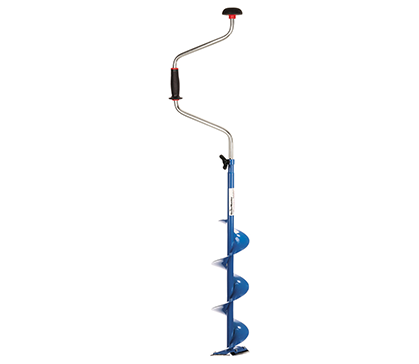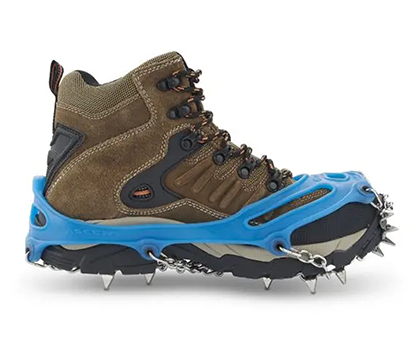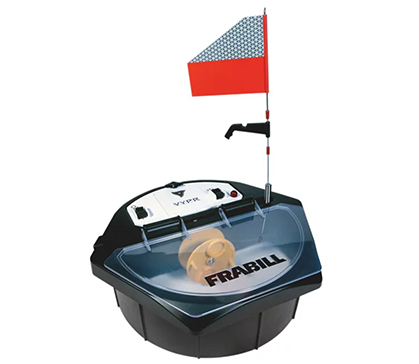How To Go Ice Fishing: The Complete Guide
Ice fishing offers a unique and rewarding challenge for anglers willing to brave the cold. When the lakes freeze over and open water opportunities are gone, it’s time to pull out the auger, set up a portable shelter, and prepare for an entirely different fishing experience.
This ice fishing guide covers everything you need to know, from understanding ice conditions to selecting the right tackle.
Preparation and Safety Measures
Thorough preparation and a commitment to safety are essential when venturing onto the ice for fishing. Ice fishing comes with unique challenges, and skipping proper planning can lead to dangerous situations. Recognizing ice conditions, packing the right gear, and following safety protocols are key to a successful and safe fishing trip in cold weather.
Understand Ice Conditions
The thickness and quality of the ice are critical for safety in ice fishing. Generally, at least 4 inches of solid, clear ice is needed to walk on safely. Plan for a minimum of 5 to 7 inches for snowmobiles or ATVs. Larger vehicles, such as trucks, require a sturdy base of 9 to over 20 inches of solid ice to safely support their weight.
Most experienced anglers rely on drilling test holes with an auger or using a spud bar to check ice thickness. Clear, black ice is generally stronger and more dependable than milky or white ice, which tends to be structurally weaker. Always remain alert for warning signs like visible cracks, slushy areas, or spots near inlets and currents, as these can indicate unstable and potentially dangerous ice conditions.
Essential Gear Checklist
The right equipment is crucial for a safe and successful ice fishing trip. Pack these essential items:

- Ice augers. Whether manual or powered, an ice auger is used to drill holes in the ice. Hand augers are lighter but require more effort, while power augers can drill multiple holes quickly and efficiently.
- Rods, reels, and tip-ups. Ice fishing rods are much shorter than standard rods, typically 24” to 36” long. Combined with a quality reel built for cold conditions, this pairing is perfect for catching fish beneath the ice. Tip-ups allow you to fish several holes at once, alerting you to a catch by raising a flag when a fish bites.
- Tackle specific to ice fishing. Choose tackle designed for cold weather. Smaller jigs and lures work best for species like walleye and perch, and live bait like minnows is also an excellent option.
- Clothing and accessories. Dress in layers to stay warm. Begin with base layers made from moisture-wicking materials, followed by insulated mid-layers, and finish with a windproof, waterproof outer layer. Insulated boots with ice spikes for added traction, waterproof gloves, and a hat or balaclava will protect you from the harsh winter conditions.

Safety Equipment

When venturing onto early-season or uncertain ice, safety must come first. Packing essential gear like life jackets or float suits provides buoyancy in case of an unexpected fall through.
Ice picks worn around the neck are essential—they provide the grip needed to pull yourself out if you break through the ice. Attaching ice cleats to your boots adds traction on slippery surfaces, helping to prevent slips and falls. Having throw ropes on hand lets you quickly assist anyone who may fall through a weak spot.
Select the Perfect Location
Finding the best spots means studying lake maps for depth variations, known fish habitats, and underwater structures like weed beds, drop-offs, and rocky points—prime areas where fish are more likely to be active.
Find a Fishing Spot
Begin by researching nearby lakes and ponds that are home to your target species, like walleye, perch, or trout. Understanding the lake’s ecosystem—including water temperature, available forage, and seasonal patterns—can help identify areas where these fish are likely to be more active.
Ensure the lake is open for ice fishing and familiarize yourself with local regulations, as these may outline open seasons, size limits, and bag limits for each species.
Navigate Fishing Regulations
Every region has specific fishing regulations that anglers must follow, so staying informed is essential before heading out on the ice. In most places, a valid fishing license and permits are required, so ensure you carry the correct documentation.
Pay close attention to size and bag limits for your target species. These rules help sustain healthy fish populations by controlling the number and size of fish kept. Also know the closed seasons, which protect certain species during important times like spawning. Fishing outside these seasons can result in fines and penalties.
Reading Maps and Using Technology
Technology can elevate your ice fishing experience, giving you an advantage in finding productive waters. Lake contour maps are invaluable for locating underwater structures like drop-offs, submerged humps, and weed lines—prime areas where fish tend to gather due to shifts in depth, cover, and temperature gradients.
With fish finders or sonar units, you can track fish activity in real time and observe their movements, while GPS units let you mark successful spots and map a reliable route back. Together, these tools can improve your chances of catching more fish throughout the day.
Ice Fishing Techniques
Once you’ve chosen your spot, it’s time to focus on the techniques that will lead to success on the ice. Mastering these methods will boost your chances of landing fish, whether you are a novice or an experienced angler.
Drill the Hole
Drilling a hole in the ice is the first step to reaching the fish below. A hand auger is a great choice if you’re only drilling a few holes or dealing with thinner ice, though it does require some physical effort. A power auger is ideal for thicker ice or multiple holes, offering efficiency for more serious anglers.
For the fastest, most effective way to drill a hole in the ice, apply steady pressure, ensuring the auger stays at a 90° angle for a clean cut. Once the hole is drilled, use a skimmer to clear away the slush and ice chips to keep the hole open and ready for fishing.
Set Up Your Fishing Gear

After drilling the hole, it’s time to set up your gear. Tip-ups are an excellent option for monitoring multiple holes at once. Position them strategically around areas where fish are likely to be, such as near underwater structures or along drop-offs. The flag on the tip-up will rise when a fish bites, signaling you to reel it in.
Jigging is another popular technique, especially for anglers who prefer a more hands-on approach. This involves moving a lure up and down through the water column to mimic prey, attracting fish to bite. Start with small, gentle movements, as fish tend to be sluggish in cold water.
Bait and Lure Selection
Choosing the right bait or lure is essential for attracting your target species. For fish like walleye, perch, and trout, live bait options such as minnows, wax worms, and spikes work exceptionally well, offering a natural scent and movement that entices bites under the ice.
Flashy jigs or spoons in bright colors like chartreuse or orange are great for catching a fish’s attention in murky water. On clearer ice, more subtle presentations with natural or neutral-colored jigs are more effective.
Adjusting your selection by experimenting with different sizes and colors helps you find what works best each day, aligning with fish behavior and water conditions.
Weather and Environmental Considerations
Successful ice fishing often relies on staying tuned into weather and environmental factors. Understanding how changes in temperature, pressure, and ice conditions impact fish behavior allows you to adapt your strategy and approach each outing with better awareness.
How Weather Impacts Fish Activity
Barometric pressure is a major influence on fish behavior. A sudden drop in pressure, often signaling an approaching storm, can trigger a feeding frenzy, making fish more aggressive and active. However, when the barometer rises, fish hunker down and become less responsive.
Temperature shifts also play a role, as colder conditions generally slow a fish’s metabolism, making them less likely to strike. Planning your outings around low-pressure periods, when fish tend to be more active, can boost your chances of a successful catch.
Read Snow and Ice Conditions
Ice conditions can be unpredictable, with slush layers or heavy snow posing challenges. Slushy patches are a warning sign, often indicating weaker ice below as water seeps up. Deep snow insulates the ice, leading to soft spots and uneven thickness.
Check ice depth and quality frequently using a spud bar or auger, especially when temperatures vary or snow cover builds up. Avoid thin or discolored ice, which often signals instability and potential hazards.
Staying Comfortable on the Ice
Ice fishing is far more enjoyable when you’re warm and comfortable. A few simple steps to shield yourself from the cold can make a difference in your fishing experience.
Portable Shelters and Heat Sources
Portable ice shacks or windbreaks can shield you from biting winds, making your day on the ice much more comfortable. Invest in a portable heater, but ventilate your shelter to prevent carbon monoxide buildup.
Food and Hydration
Pack plenty of high-energy snacks like nuts, jerky, or energy bars, and bring hot beverages to stay warm. Staying hydrated is just as important in the cold, so have enough water. Dispose of waste responsibly to leave the environment clean for others.
Ice Fishing Etiquette
While ice fishing is an exciting way to enjoy the outdoors, it is important to respect others on the ice. Following basic etiquette ensures that everyone can enjoy their experience.
Respecting Personal Space
Ice fishing often has a communal feel, but giving fellow anglers enough space is respectful. Ideally, maintain a distance of 50 to 100 feet between your hole and others, especially in crowded areas. This helps prevent tangled lines and allows everyone to enjoy their own fishing space peacefully.
Leave No Trace
Leave No Trace means packing all your waste, including fishing lines, bait containers, and food wrappers. Trash left behind can be hazardous for wildlife and other anglers.
Common Mistakes and Troubleshooting Tips
Even experienced anglers run into problems on the ice. Here are some common issues and how to avoid them.
Over-drilling and Over-fishing in One Spot

It might be time to move if you’ve drilled multiple holes and aren’t seeing action. Fish can be elusive, so try scouting new areas after a while instead of staying put. Using fish finders or maps can help locate more productive spots.
Equipment Malfunctions
Cold weather can cause reels to freeze or lines to tangle. To warm frozen reels gently, use your hands or a heater, but be cautious not to overheat. Keeping spare parts for equipment and ensuring your blades stay sharp helps minimize downtime due to malfunctions.
Gear Up and Get Ice Fishing With Fish307
If you are ready to start your ice fishing adventure, this ice fishing guide is just the beginning. FISH307 has everything you need, from augers and shelters to the latest electronics and safety gear. Our experienced team can help you select the right equipment for your needs and fishing style.
Contact us to connect with our team of ice-fishing experts. We’ll help you get set up with the right gear and knowledge to make your ice fishing experience safe, comfortable, and successful!
Recent Posts
-
How To Go Ice Fishing: The Complete Guide
Ice fishing offers a unique and rewarding challenge for anglers willing to brave the cold. When the
-
3 Top Pro Angler Tips for Improving Casting Distance and Accuracy
Maximizing casting distance and honing accuracy are fundamental skills every serious angler needs




